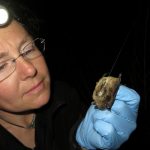As Halloween approaches, bat enthusiasts around BC are celebrating and supporting bats by participating in International Bat Week (October 24-31).
Bat Week is all about appreciating these amazing animals and their benefits, from eating insects to pollinating the agave plant used to make tequila. Take a moment to learn about the many ways bats contribute to our lives, and what you can do locally for bats, at www.batweek.org or through the BC Community Bat Program at www.bcbats.ca.
“Bats in BC help control agricultural and forest pests, as well as mosquitoes in our yards – but now bats need our help” says Mandy Kellner, Coordinator for the BC Community Bat Program. “The conservation of bats in BC has always been important, since over half the species in this province are considered at risk. With the continuing spread of White-nose Syndrome in Washington State, bat conservation is more important than ever.”
White-nose Syndrome (WNS) is a disease caused by an introduced fungus, first detected in North America in a cave in New York in 2006. Since it was discovered, it has spread to 33 states and 7 provinces in North America, decimating bat populations along the way. “Luckily, WNS is not yet in BC” continues Kellner, “But we are preparing for its arrival by raising awareness about bats, working with landowners who have bats in buildings, enhancing bat habitat, and monitoring populations.”
Monitoring for WNS in BC will continue this winter, with Community Bat Programs requesting reports of dead bats or sightings of winter bat activity starting November 1. You can report sightings at www.bcbats.ca, info@bcbats.ca, or 1-855-922-2287.
In partnership with the BC Ministry of Environment, and funded by the Habitat Conservation Trust Foundation, Forest Enhancement Society of BC, Habitat Stewardship Program, and regional funders, the BC Community Bat Program provides information about bats in buildings, conducts site visits to advise landowners on managing bats in buildings, coordinates the Annual Bat Count, and offers educational programs on bats.
To find out more about the BC Community Bat Program, BatWeek activities, and options for helping local bat populations, visit www.bcbats.ca or call or 1-855-922-2287.

Cottonwoods and wetlands: Protecting wetlands and old trees ensures that threatened bat populations have the habitats they need. Photo: H van Oort.

Bat houses offer roost sites when natural features such as old trees are rare. Find details at www.bcbats.ca Photo: V Reznicek.
 Read more about the bat probiotic project: Seeking ways to protect western bats from deadly white-nose syndrome
Read more about the bat probiotic project: Seeking ways to protect western bats from deadly white-nose syndrome
See CBC’s recent story on the bat probiotics project: Fighting a bat killer: B.C. scientists testing new way to protect against deadly fungus
Find out more about other HCTF-funded bat projects at: https://hctf.ca/grants-support-bat-conservation-education-and-fight-against-white-nose-syndrome/







